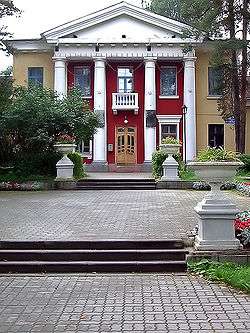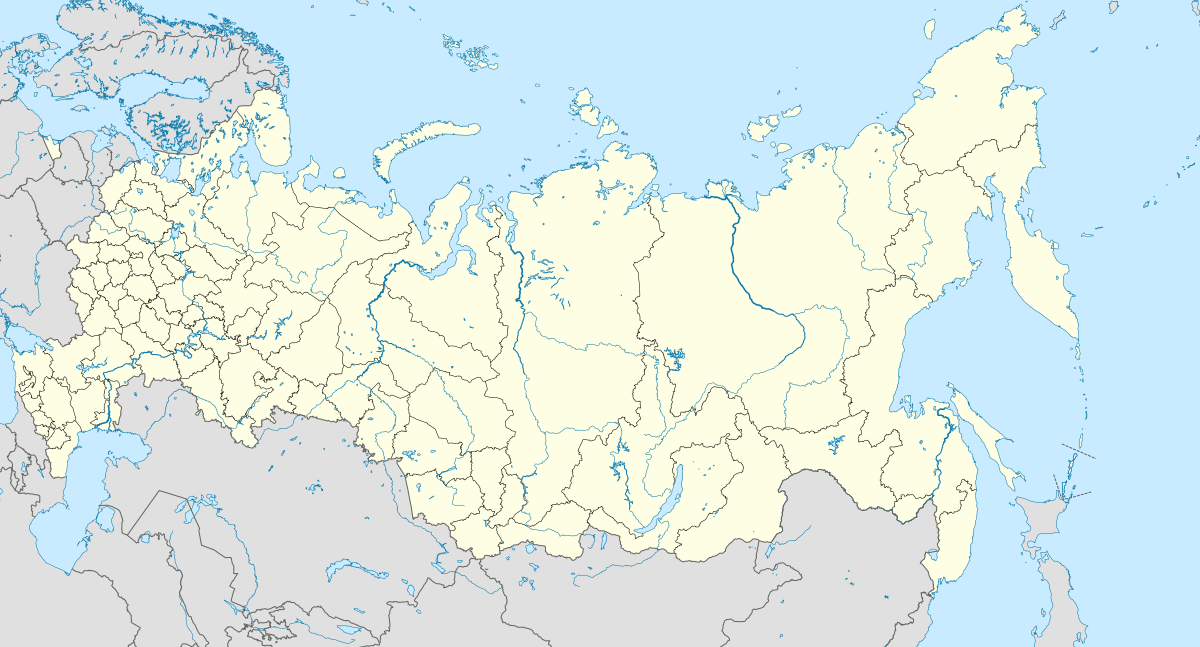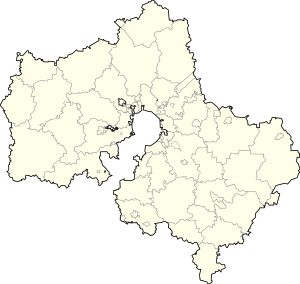Dubna
Dubna (Russian: Дубна́, IPA: [dʊbˈna]) is a town in Moscow Oblast, Russia. It has a status of naukograd (i.e. town of science), being home to the Joint Institute for Nuclear Research, an international nuclear physics research center and one of the largest scientific foundations in the country. It is also home to MKB Raduga, a defense aerospace company specializing in design and production of missile systems. The modern town was developed in the middle of the 20th century and town status was granted to it in 1956. Population: 70,663 (2010 Census);[2] 60,951 (2002 Census);[7] 65,805 (1989 Census).[8]
Dubna Дубна | |
|---|---|
Town[1] | |
 Headquarters of JINR in Dubna | |
_(2003).png) Flag _(2003).png) Coat of arms | |
Location of Dubna 
| |
 Dubna Location of Dubna  Dubna Dubna (Moscow Oblast) | |
| Coordinates: 56°44′N 37°10′E | |
| Country | Russia |
| Federal subject | Moscow Oblast[1] |
| Founded | 1956 |
| Government | |
| • Mayor | Maxim Danilov |
| Elevation | 125 m (410 ft) |
| Population | |
| • Total | 70,663 |
| • Estimate (2018)[3] | 75,144 (+6.3%) |
| • Rank | 223rd in 2010 |
| • Subordinated to | Dubna Town Under Oblast Jurisdiction[1] |
| • Capital of | Dubna Town Under Oblast Jurisdiction[1] |
| • Urban okrug | Dubna Urban Okrug[4] |
| • Capital of | Dubna Urban Okrug[4] |
| Time zone | UTC+3 (MSK |
| Postal code(s)[6] | 141980 |
| Dialing code(s) | +7 49621 |
| OKTMO ID | 46718000001 |
| Website | www |
Geography
The town is 120 meters (390 ft) above sea level, situated approximately 125 kilometers (78 mi) north of Moscow, on the Volga River, just downstream from the Ivankovo Reservoir. The reservoir is formed by a hydroelectric dam across the Volga situated within the town borders. The town lies on both banks of the Volga. The western boundary of the town is defined by the Moscow Canal joining the Volga, while the eastern boundary is defined by the Dubna River joining the Volga.
Dubna is the northernmost town of Moscow Oblast.
History
Pre-World War II
Fortress Dubna (Russian: Дубна) belonging to Rostov-Suzdal Principality was built in the area in 1132 by the order of Yuri Dolgoruki and existed until 1216. The fortress was destroyed during the feudal war between the sons of Vsevolod the Big Nest. The village of Gorodishche (Городище) was located on the right bank of the Volga River and was a part of the Kashin Principality. Dubna customs post (Дубненское мыто) was located in the area and was a part of the Principality of Tver.
Before the October Revolution, few villages were in the area: Podberezye was on the left bank of the Volga, and Gorodishche, Alexandrovka, Ivankovo, Yurkino, and Kozlaki (Russian: Козлаки) were on the right bank.
Right after the Revolution one of the first collective farms was organized in Dubna area.
In 1931, the Orgburo of the Communist Party made a decision to build the Volga-Moscow Canal. Genrikh Yagoda, then the leader of the State Political Directorate, was put in charge of construction. The Canal was completed in 1937. Ivankovo Reservoir and Ivankovo hydroelectrical plant were also created as a part of the project. Many villages and the town Korcheva were submerged under water. Dubna is mentioned in Aleksandr Solzhenitsyn's book The Gulag Archipelago as the town built by Gulag prisoners.
Science
The decision to build a proton accelerator for nuclear research was taken by the Soviet government in 1946. An impractical place where the current town is situated was chosen due to remoteness from Moscow and the presence of the Ivankovo power plant nearby. The scientific leader was Igor Kurchatov. The general supervisor of the project including construction of a settlement, a road and a railway connecting it to Moscow (largely involving penal labour of Gulag inmates) was the NKVD chief Lavrentiy Beria. After three years of intensive work, the accelerator was commissioned on December 13, 1949.
The town of Dubna was officially inaugurated in 1956, together with the Joint Institute for Nuclear Research (JINR), which has developed into a large international research laboratory involved mainly in particle physics, heavy ion physics, synthesis of transuranium elements, and radiobiology. In 1960, a town of Ivankovo situated on the opposite (left) bank of the Volga was merged into Dubna. In 1964, Dubna hosted the prestigious International Conference on High Energy Physics.
Outstanding physicists of the 20th century including Nikolay Bogolyubov, Georgy Flyorov, Vladimir Veksler, and Bruno Pontecorvo used to work at the institute. A number of elementary particles and nuclei of transuranium elements (most recently, element 117) have been discovered and investigated there, leading to the honorary naming of chemical element 105 dubnium (Db) for the town.
Administrative and municipal status
Within the framework of administrative divisions, it is incorporated as Dubna Town Under Oblast Jurisdiction—an administrative unit with the status equal to that of the districts.[1] As a municipal division, Dubna Town Under Oblast Jurisdiction is incorporated as Dubna Urban Okrug.[4]
Demographics
| Year | Pop. | ±% |
|---|---|---|
| 1959 | 14,000 | — |
| 1970 | 43,700 | +212.1% |
| 1979 | 54,900 | +25.6% |
| 1989 | 65,800 | +19.9% |
| 2003 | 61,000 | −7.3% |
| 2008 | 62,500 | +2.5% |
| 2010[2] | 70,663 | +13.1% |
| 2012[9] | 72,357 | +2.4% |
| Source: [10] unless indicated otherwise | ||
Economics
Before the dissolution of the Soviet Union, JINR and MKB Raduga were the main employers in the town. Since then their role has decreased significantly. Several small industrial enterprises have emerged, however the town still experiences some employment difficulties. Proximity to Moscow allows many to commute and work there. Plans by AFK Sistema and other investors including government structures have been announced to build a Russian analogue of Silicon Valley in Dubna. As of the beginning of 2007, nothing has commenced.
Transport
The public transport connections to Moscow include express trains, suburban trains and bus shuttles which depart from the Savyolovsky Rail Terminal.
Culture
Since 2007 Dubna is a headquarters and primary location of international jazz festival MuzEnergo[11] with free for public one-day open air festival in summer and one-week events in local venues in spring and autumn.
There are several museums in Dubna, including:[12]
- Museum of Archeology and Local History of Dubna
- The JINR Museum of the History of Science and Technology
- Museum of Natural History at Dubna International University
- Museum of Locks
Sports
Dubna's sports facilities include two stadiums, a waterski stadium on the Volga River, three swimming pools, tennis courts, and five sports complexes.
Popular water sports in Dubna include windsurfing, kitesurfing, and water-skiing.
Since 2004, Dubna has been a venue for Waterski World Cup stops. Dubna is a venue for the 2011 World Waterski Championships (July, 17-24 2011).[13]
Trivia
One of the world's tallest statues of Vladimir Lenin, 25 meters (82 ft) high, built in 1937, is located at Dubna at the confluence of the Volga River and the Moscow Canal. The accompanying statue of Joseph Stalin of similar size was demolished in 1961 during the period of de-stalinization.[14]
Gallery
- Ilyushin Il-2 in a war memorial in Dubna
- Plaque concerning the Ilyushin Il-2 war memorial in Dubna
- Russian locomotive class 9P number 9P512 outside the Bolshoi Volga railway station in Dubna
- Monument to the Mikoyan-Gurevich MiG-25 in Dubna
Twin towns and sister cities
Dubna is twinned with:[15]
References
Notes
- Law #11/2013-OZ
- Russian Federal State Statistics Service (2011). "Всероссийская перепись населения 2010 года. Том 1" [2010 All-Russian Population Census, vol. 1]. Всероссийская перепись населения 2010 года [2010 All-Russia Population Census] (in Russian). Federal State Statistics Service.
- "26. Численность постоянного населения Российской Федерации по муниципальным образованиям на 1 января 2018 года". Federal State Statistics Service. Retrieved January 23, 2019.
- Law #84/2005-OZ
- "Об исчислении времени". Официальный интернет-портал правовой информации (in Russian). June 3, 2011. Retrieved January 19, 2019.
- Почта России. Информационно-вычислительный центр ОАСУ РПО. (Russian Post). Поиск объектов почтовой связи (Postal Objects Search) (in Russian)
- Russian Federal State Statistics Service (May 21, 2004). "Численность населения России, субъектов Российской Федерации в составе федеральных округов, районов, городских поселений, сельских населённых пунктов – районных центров и сельских населённых пунктов с населением 3 тысячи и более человек" [Population of Russia, Its Federal Districts, Federal Subjects, Districts, Urban Localities, Rural Localities—Administrative Centers, and Rural Localities with Population of Over 3,000] (XLS). Всероссийская перепись населения 2002 года [All-Russia Population Census of 2002] (in Russian).
- "Всесоюзная перепись населения 1989 г. Численность наличного населения союзных и автономных республик, автономных областей и округов, краёв, областей, районов, городских поселений и сёл-райцентров" [All Union Population Census of 1989: Present Population of Union and Autonomous Republics, Autonomous Oblasts and Okrugs, Krais, Oblasts, Districts, Urban Settlements, and Villages Serving as District Administrative Centers]. Всесоюзная перепись населения 1989 года [All-Union Population Census of 1989] (in Russian). Институт демографии Национального исследовательского университета: Высшая школа экономики [Institute of Demography at the National Research University: Higher School of Economics]. 1989 – via Demoscope Weekly.
- Народная энциклопедия городов и регионов России «Мой Город»
- Jazz festival "MuzEnergo" official web site Archived March 2, 2010, at the Wayback Machine
- Official list of Dubna museums
- The Organizing Committee of the 2011 World Waterski Championships official web site Archived April 24, 2011, at the Wayback Machine
- Salys, Rimgaila (2009). The Musical Comedy Films of Grigorii Aleksandrov: Laughing Matters. Intellect Books. p. 271.
- Dubna partnership
- pl:Dubna
Sources
- Московская областная Дума. Закон №11/2013-ОЗ от 31 января 2013 г. «Об административно-территориальном устройстве Московской области», в ред. Закона №249/2019-ОЗ от 29 ноября 2019 г. «О внесении изменений в Закон Московской области "Об административно-территориальном устройстве Московской области"». Вступил в силу на следующий день после официального опубликования (13 января 2013 г.). Опубликован: "Ежедневные Новости. Подмосковье", №24, 12 февраля 2013 г. (Moscow Oblast Duma. Law #11/2013-OZ of January 31, 2013 On the Administrative-Territorial Structure of Moscow Oblast, as amended by the Law #249/2019-OZ of November 29, 2019 On amending the Law of Moscow Oblast "On the Administrative-Territorial Structure of Moscow Oblast". Effective as of the day following the day of the official publication (January 13, 2013).).
- Московская областная Дума. Закон №84/2005-ОЗ от 28 февраля 2005 г. «О статусе и границе городского округа Дубна», в ред. Закона №52/2009-ОЗ от 22 мая 2009 г «О внесении изменений в Закон Московской области "О статусе и границе городского округа Дубна"». Вступил в силу со дня официального опубликования. Опубликован: "Ежедневные Новости. Подмосковье", №44, 12 марта 2005 г. (Moscow Oblast Duma. Law #84/2005-OZ of February 28, 2005 On the Status and the Border of Dubna Urban Okrug, as amended by the Law #52/2009-OZ of May 22, 2009 On Amending the Law of Moscow Oblast "On the Status and the Border of Dubna Urban Okrug". Effective as of the day of the official publication.).
External links
- (in Russian) News of Dubna
- (in Russian) History of Dubna